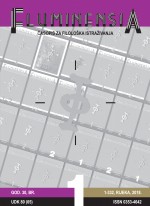COMPARISON OF SPEECH RATE IN CROATIAN AS A NATIVE LANGUAGE (L1) AND ENGLISH AS A FOREIGN LANGUAGE (L2)
Keywords:
speech rate, speech production, fluency, mental lexiconAbstract
This paper aims at investigating the differences regarding speech rate between the Croatian (L1) and the English language (L2). The selected tasks include descriptions of dynamic entities which require careful planning and a chronological sequence of speech acts in real time, as well as the description of static spatial arrangements and their relations. The speech tasks were first performed in the native language, followed by the performance of the same tasks in the foreign language. A significantly faster speech rate was hypothesized in the foreign language condition for each investigated speech task due to the unautomated nature of L2 speech production mechanisms. The obtained results point to the conclusion that the speech rate is significantly slower in L2 in narrative tasks due to the conceptual complexity of the task. However, no significant differences in the speech rate were found between the two languages in the case of highly structured tasks with shorter duration, or in the case of repeated tasks. Due to the fact that the tasks have already been performed in the native language, the processing demands on the level of conceptualization decrease, freeing up the attentional resources, which, in turn, assist the formulation and articulation stage by reducing the processing pressure. Also, the fact that no significant differences were found might be explained by the existence of strong associative links between L1 and L2, as well as by the occurrence of highly frequent words which can be easily retrieved from the mental lexicon, especially if they have previously been activated in the native language. Introduction of new topics, on the other hand, implies higher cognitive demands in the conceptualization stage, resulting in a slower speech rate in both languages.

